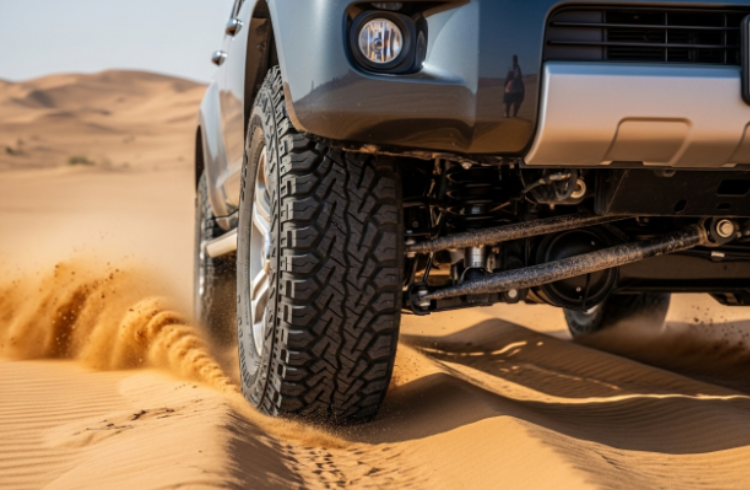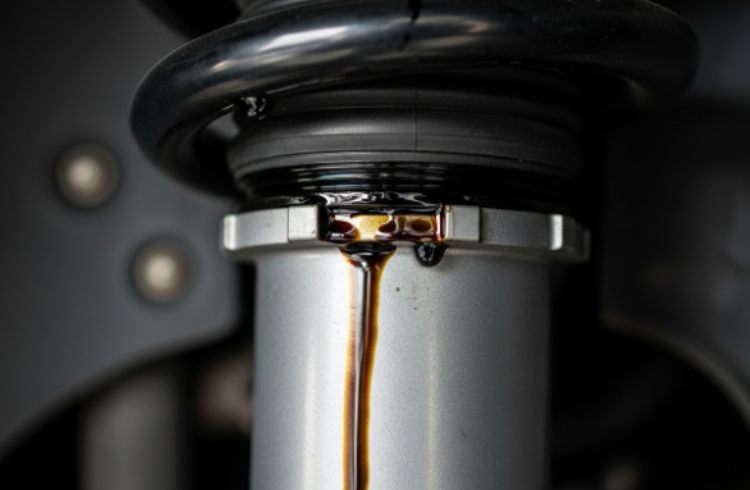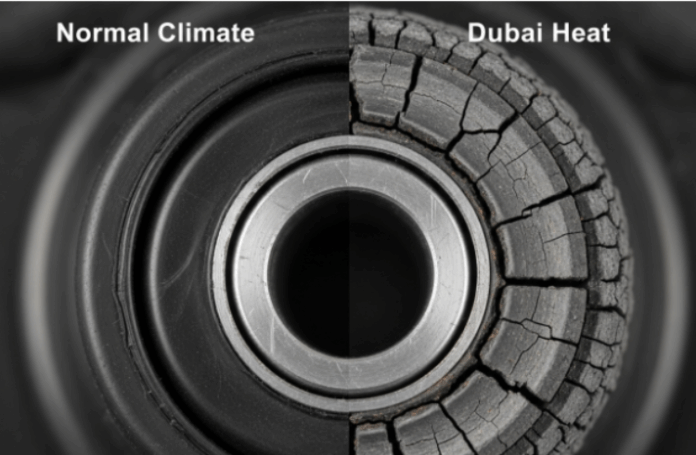Dubai’s infrastructure showcases some of the world’s finest roads, yet your vehicle’s suspension and alignment face unique challenges every single day. Streets in Dubai scored 95 percent on the Road Pavements Condition Index in 2022, but even with excellent road quality, specific driving conditions in the Emirates demand constant attention to your car’s underbody components.
Whether you navigate the industrial corridors of Al Quoz for work, cruise Sheikh Zayed Road for your daily commute, or occasionally venture onto desert tracks during weekends, understanding how Dubai’s varied terrain affects your suspension and alignment can save you thousands of dirhams in repairs. For routine maintenance and expert inspections, reliable car service in Al Quoz providers can help you stay ahead of potential problems before they become expensive nightmares.
Frequent driving on uneven roads like rough terrains and potholes accelerates suspension deterioration. The UAE’s hot climate can impact rubber suspension components, causing them to crack and degrade over time. This combination of environmental factors makes monitoring your suspension health more critical in Dubai than in most other cities globally.
Why Dubai’s Roads Present Unique Suspension Challenges
The Paradox of Excellent Infrastructure
The UAE’s highways are considered the best quality in the world according to the World Economic Forum’s Global Competitiveness Report. Roads scored 6.6 points on a scale of 1 to 7. However, this doesn’t mean your suspension gets an easy ride.
High-quality highways encourage higher speeds. On UAE highways where speeds often hit 120 to 140 km/h, vibrations from any imbalance or misalignment amplify significantly.
This wears suspension components faster than you might expect. The smooth roads create a false sense of security. Drivers often miss early warning signs until damage becomes severe.
Residential Areas and Industrial Zones
Areas like Al Quoz Industrial present a different challenge entirely. The constant presence of heavy trucks, frequent loading zones, and service roads creates localized stress on pavements.
During heavy rain events, areas including Al Quoz Industrial Area 3 near Al Madina Supermarket on Al Asayel Street have experienced flooding. This can temporarily create potholes and surface damage that impact suspension components.
Speed bumps are everywhere throughout Dubai’s residential neighborhoods and near schools. Frequent speed bump encounters in residential and commercial areas across the UAE can gradually affect wheel alignment over time.
Experts recommend alignment checks every three months for vehicles regularly encountering them. When approached incorrectly at excessive speeds, these traffic calming measures become suspension destroyers rather than safety features.
Heat: The Silent Suspension Killer
The UAE’s scorching 50-degree Celsius temperatures soften tire rubber. This amplifies imbalance effects and causes premature wear. Heat makes balance issues more pronounced on highways. But heat doesn’t stop at tires.
The extreme heat and road surface conditions in the UAE can worsen tire wear issues caused by misalignment. Prolonged high-temperature environments affect rubber suspension components.
Rubber bushings, mounting points, and seals deteriorate faster under constant thermal stress. What might last five years in moderate climates can fail in three years or less in Dubai’s summer conditions.
Common Road Conditions in Dubai That Damage Suspension
Potholes: Rare But Devastating
Dubai’s RTA ensures smooth and well-maintained roads. This means you will hardly find potholes in the UAE. Bad weather or certain incidents can damage roads temporarily. When potholes do appear, the impact is severe.
The car suspension is responsible for absorbing shocks when going through potholes. Sudden movements greatly accelerate the wear of suspension components.
This includes bushings, arms, bearings, and trays. In serious cases, permanent suspension damage occurs. Shock absorber fluid leaks, and components lose their efficiency.
What to watch for after hitting a pothole:
- Fluid leaks underneath the vehicle
- Unusual noises when going over bumps
- Vehicle pulling to one side
- Uneven tire wear appearing within days
Residents can report road damage, including potholes, by calling the toll-free number 800 88889 for federal roads in the UAE. This helps authorities maintain road quality.
Speed Bumps: The Daily Suspension Test

Residential areas in Dubai typically have speed limits set between 25 km/h and 40 km/h. Speed bumps are installed in high-risk areas to deter speeding. These features are necessary for safety, but punishing for suspension when mishandled.
Proper speed bump navigation:
- Reduce speed to 5-10 km/h before contact
- Approach straight, centering your vehicle
- Never brake while on the bump itself
- Maintain a steady throttle through the obstacle
Approaching speed bumps slowly helps avoid jarring impacts. Using the center of the lane provides even weight distribution. Avoiding overloading prevents excess weight from straining the suspension. This makes bumps less damaging to your car.
Desert Tracks and Off-Road Excursions

Weekend desert driving is a beloved UAE tradition. It takes a serious toll on suspension systems designed primarily for paved roads. Full-size SUVs with true four-wheel-drive systems have higher ground clearance and stronger suspension. They handle rough terrain and soft sand better than compact SUVs.
Even occasional desert driving causes:
- Accelerated wear on shock absorbers from constant compression and extension
- Misalignment from lateral impacts on uneven terrain
- Dust and sand infiltration into suspension joints
- Stress on the control arms and bushings from torsional forces
If you regularly venture off-road, you should clean sand particles from suspension components after sandstorms.
Sand and dust can accumulate in the suspension system. This affects its geometry and potentially leads to misalignment. Regularly washing the undercarriage after sandstorms is advisable.
Construction Zones and Temporary Road Conditions
The RTA conducted reconstruction work on a 14-kilometer stretch of Emirates Road recently. Inspection vehicles detected a drop in the Pavement Quality Index to around 85 percent in some sections. This was mainly due to heavy truck traffic. During such maintenance periods, drivers encounter:
- Uneven lane transitions
- Temporary asphalt patches
- Exposed road edges
- Changed surface textures
These temporary conditions can knock alignment out of specification surprisingly quickly. This is especially true if you encounter them daily during commutes.
Critical Components to Monitor
Shock Absorbers and Struts

Your shock absorbers control spring oscillation. They keep tires in contact with the road surface. Healthy shocks are free of oil and moisture. Seeing oil leaking from shock absorbers is a sure sign that repair is needed.
Warning signs:
- Excessive bouncing after going over bumps (more than 1-2 bounces)
- Nose-diving when braking
- Rear squat during acceleration
- Visible fluid on the shock body
- Uneven tire wear patterns
In Dubai, experts recommend a full suspension check-up every 10,000 to 15,000 km. This includes assessment of shocks, struts, bushings, control arms, and springs.
Wheel Alignment Angles
Proper wheel alignment involves three critical angles:
Camber: When you look at your tires from the front of your car, you see the angle of the wheel. This is denoted by degrees and called the camber. The upper half leaning away indicates positive degrees. Leaning towards indicates negative degrees. Misalignment causes excessive wear on one side of the tire.
Caster: Whenever you make turns on the steering wheel, there’s a pivot on the suspension. This allows your tires to respond quickly. This angle affects straight-line stability and steering returnability.
Toe: The angle of tires when viewed from above. An incorrect toe is the fastest cause of tire wear. It can sometimes destroy tread in just weeks.
Abnormal tire wear shows inner or outer edges with feathering or sawtooth patterns. This is common on high-temperature UAE roads. The extreme heat and road surface conditions worsen tire wear issues caused by misalignment.
Control Arms, Ball Joints, and Bushings
Ball joints allow wheels to move up and down. They also enable wheels to turn left and right. They can wear out over time due to constant use and exposure to road conditions. This leads to uneven tire wear, drifting while driving, and clunking noises when turning.
Inspection technique:
- Raise the vehicle safely on jack stands
- Grasp the tire at the 12 and 6 o’clock positions
- Rock the tire back and forth
- Any play or clunking indicates worn components
The extreme heat in the UAE can degrade rubber components faster. Experts recommend high-temperature-resistant rubber components for suspension parts when replacements are needed.
Tie Rods and Steering Linkages
These connect your steering wheel to your wheels. Worn tie rods create:
- Wandering steering feel
- Excessive play in the steering wheel
- Uneven tire wear
- Vehicle pulling during braking
Warning Signs Your Suspension or Alignment Needs Attention
Immediate Red Flags
Vehicle Pulling to One Side: If your vehicle tends to drift or pull to one side while driving straight, your wheels might be out of alignment. This makes driving more challenging and increases tire wear. This is especially noticeable on Dubai’s long, straight highways. You shouldn’t need constant steering corrections.
Steering Wheel Off-Center: Your steering wheel should be centered when driving straight. If it’s noticeably off-center even though your vehicle is moving straight, you may need wheel alignment service. On Sheikh Zayed Road or Emirates Road, this becomes immediately apparent.
Unusual Vibrations: Shaking in the steering wheel or seats at speeds above 80 km/h indicates imbalance. This is especially noticeable on Dubai’s E44. Vibrations that intensify with speed suggest tire balance or alignment issues.
Uneven or Rapid Tire Wear: Misalignment issues not only affect suspension but also cause uneven tire wear. This increases the chance of suspension failure over time. Check your tires monthly for:
- Wear on one edge only
- Center wear (overinflation)
- Edge wear on both sides (underinflation)
- Cupping or scalloping patterns
- Feathering on tread blocks
Subtle Changes to Monitor
Increased Road Noise: As suspension components wear, road noise amplifies. What was once a quiet cruise on Sheikh Mohammed Bin Zayed Road becomes increasingly louder. This is especially true over expansion joints and small imperfections.
Decreased Ride Comfort: Regular care of the suspension system improves ride comfort. It also improves braking performance and tire life. Well-maintained suspension ensures precise steering and even tire wear. If your car feels harsher over bumps you previously barely noticed, suspension wear is progressing.
Longer Braking Distances: Neglecting car suspension problems can lead to severe consequences. This includes increased braking distance and loss of control. Worn shocks reduce tire contact with pavement during braking. This extends the stopping distance dangerously.
Unusual Noises: Listen for:
- Clunking over bumps (worn bushings or mounts)
- Squeaking during turns (ball joints or tie rods)
- Knocking when changing direction (strut mounts)
- Creaking when rocking the vehicle (spring seats)
Proactive Monitoring Schedule for Dubai Conditions
Monthly Visual Inspections
What you can check yourself:
Tire Condition: Check tread depth regularly. Use the coin test or a tread depth gauge. Anything less than 1.6 mm is a danger sign. You need to get tires changed.
Visible Damage: Look under your vehicle for:
- Fluid leaks near shocks
- Torn rubber boots
- Bent components
- Loose hardware
Tire Pressure: In the UAE, temperatures reach very high levels during summer. This causes air to expand, leading to over-inflation or quick deflation. Under-inflated tires wear out and consume fuel more quickly.
Every 5,000-10,000 KM
Getting your vehicle’s wheel alignment serviced every 6,000 to 10,000 km is recommended. You should also get it checked at least once a year. This is true even if you are not experiencing any noticeable problems.
Professional services needed:
- Computerized wheel alignment check
- Tire rotation and balancing
- Suspension component inspection
- Brake system evaluation
Schedule balancing every 5,000 to 8,000 km. You should also do this after installing new tires. This maintains stability on the UAE’s fast-paced highways.
After Specific Events
Immediate inspection needed after:
- Hitting a pothole or a significant road hazard
- Collision or impact, even minor
- Replacing tires or suspension components
- Desert driving excursions
Impacts with kerbs are common in busy urban areas. This includes the roundabouts in Dubai and Sharjah. These can easily knock your wheels out of alignment.
Seasonal Considerations
Summer (June-September):
- More frequent pressure checks as heat causes expansion
- Inspect rubber components for heat cracking
- Monitor fluid levels in shock absorbers
- Check for tire sidewall bulges
Post-Summer (October-November):
- Comprehensive suspension inspection after summer stress
- Replace any heat-damaged rubber components
- Verify alignment after thermal expansion and contraction cycles
Winter and Cooler Months (December-March):
- Standard maintenance schedule
- Prepare for occasional rain impacts
- Monitor for early signs of wear
How Different Dubai Locations Affect Your Suspension
Al Quoz Industrial Area
The industrial character of Al Quoz means:
- Heavier traffic, including commercial vehicles
- More frequent stops and starts
- Service roads with varied surface quality
- Higher likelihood of temporary road repairs
Monitoring focus: Control arm bushings and ball joints wear faster from constant direction changes and stop-and-go traffic.
Check alignment every 8,000-10,000 km if you work in this area daily.
Sheikh Zayed Road and Major Highways
Sheikh Zayed Road speed limits range from 100-120 km/h. Sustained high-speed driving creates specific challenges.
Monitoring focus: High-speed driving on roads like Dubai’s E311 amplifies vibrations. This can wear suspension components and reduce tire life. Tire balance becomes critical. Even small alignment deviations show up as noticeable pulling or vibration.
Residential Communities
Speed bump density varies significantly. Many communities have dozens of bumps along internal roads.
Monitoring focus: Frequent speed bump encounters require alignment checks every three months. Shock absorbers experience accelerated wear from constant compression cycles.
Desert Periphery and Off-Road Areas
The UAE has a vast desert to explore. Many wadis offer challenging driving conditions. The challenges vary as sand is notoriously difficult to predict. Wadis constantly change as you progress along various surfaces.
Monitoring focus: After any desert excursion, inspect for:
- Sand accumulation in suspension joints
- Impact damage to the undercarriage
- Alignment shifts from lateral forces
- Increased play in steering components
The Cost of Neglect vs. Proactive Maintenance
Minor Issues Left Unaddressed
A slightly misaligned wheel seems harmless, but cascades into:
- Tire replacement is 30-50 percent sooner than normal
- Accelerated wear on steering components
- Reduced fuel efficiency (up to 7 percent according to studies)
- Compromised safety during emergency maneuvers
Professional service ensures optimal tire performance, safety, and vehicle stability. Compare this to:
- Premium tire set: AED 1,500-3,000 or more
- Ball joint replacement: AED 800-1,500
- Complete shock absorber set: AED 2,000-4,000 or more
Suspension Component Failure
Ignoring initial signs of damage results in larger repair bills down the road. It also causes impaired safety and issues during daily commutes. A failed ball joint doesn’t just need replacement. It likely caused:
- Uneven tire wear requiring replacement
- Damaged tie rod ends
- Possible damage to the wheel bearing
- Compromised brake components
What could have been addressed for AED 300-500 becomes an AED 3,000 or more repair bill.
Safety Implications
The UAE government introduced stricter traffic laws in 2025. These focus on vehicle maintenance as a key factor in road safety.
Mandatory vehicle inspections are enforced. These check the condition of critical components, including suspension systems.
Beyond legal requirements, failed suspension components directly cause:
- Extended emergency braking distances
- Loss of control during evasive maneuvers
- Tire blowouts from excessive wear
- Reduced crash protection
Professional vs. DIY Monitoring
What You Can Do Yourself
Monthly Bounce Test:
- Push down firmly on each corner of your vehicle
- Release quickly
- The vehicle should bounce once and settle
- More than 1-2 bounces indicates worn shocks
Visual Inspection:
- Look for oil stains near shock absorbers
- Check tire wear patterns
- Verify even tire pressure
- Listen for unusual noises during parking lot maneuvers
Straight-Line Test: On an empty, straight road:
- Briefly release the steering wheel
- The vehicle should track straight
- Immediate pulling indicates alignment issues
When Professional Diagnosis is Essential

When you bring your vehicle for wheel alignment check-ups, technicians check and reset wheel angles. These match the manufacturer’s specifications. They conduct a detailed inspection of suspension and steering systems.
Professional equipment provides:
- Precise angle measurements to 0.1-degree accuracy
- Computerized comparison to factory specifications
- Load-bearing component testing
- Detailed wear pattern analysis
Many reputable independent workshops in areas like Al Quoz in Dubai or Mussafah in Abu Dhabi offer excellent alignment services.
Choosing the Right Service Provider
Look for facilities offering:
- Modern computerized alignment equipment
- Manufacturer-specific specifications database
- Detailed before and after printouts
- Comprehensive suspension inspection included
- Warranty on alignment service
- Transparent pricing structure
Maximizing Suspension Life in Dubai’s Climate
Driving Habits That Protect Your Suspension
Speed Bump Approach: Drive over speed bumps at low speed to avoid jarring impacts. Use the center of the lane for even weight distribution. Never brake or accelerate while on the bump.
Pothole Avoidance: Following the UAE speed limit is the main tip to avoid potholes. The higher the speed, the more difficult it is to dodge holes. There’s also a risk of losing direction. Stay alert, maintain a safe following distance, and avoid puddles that may hide potholes.
Load Management: Overloading your vehicle with passengers or heavy items puts undue pressure on the suspension system. Owners are advised to follow the load limits referenced in their car manual. Exceeding GVWR (Gross Vehicle Weight Rating) accelerates component wear dramatically.
Smooth Inputs: Aggressive driving creates suspension stress:
- Hard braking transfers weight violently forward
- Rapid acceleration compresses the rear suspension
- Sharp cornering loads lateral forces on components
- Sudden lane changes stress tie rods and bushings
Environmental Protection
Parking Strategies:
- Use covered parking when possible to reduce heat exposure
- Park on level ground to prevent uneven suspension loading
- Avoid parking with wheels turned fully (strains power steering and tie rods)
Cleaning and Maintenance:
- Wash undercarriage monthly, especially after rain or dust storms
- After sandstorms, clean sand particles from suspension components
- Apply protective coatings to exposed metal components
- Check and replace cabin air filters to prevent dust accumulation
Component Upgrades for Dubai Conditions
For vehicles used extensively in harsh conditions:
- Consider using high-temperature-resistant rubber components for suspension parts when replacements are needed
- Upgrade to heavy-duty shock absorbers if frequently loaded
- Install dust boots on exposed suspension joints
- Use higher-quality synthetic lubricants in serviceable joints
FAQs About Suspension and Alignment in Dubai
Getting your vehicle’s wheel alignment serviced every 6,000 to 10,000 km is recommended. You should also do this at least once a year. This is true even if you are not experiencing any noticeable problems.
However, if you regularly drive on speed bumps or have experienced impacts, increase frequency to every 5,000-6,000 km.
Yes, but drive cautiously to a safe location. Immediately inspect for visible damage, fluid leaks, or unusual noises.
If your car accidentally passes through a pothole, it can fall at an irregular angle. This can cause an accident. Schedule a professional inspection within 24-48 hours, even if nothing seems wrong initially.
The UAE’s scorching 50-degree Celsius temperatures soften tire rubber. This amplifies imbalance effects and causes premature wear.
Additionally, the extreme heat and road surface conditions in the UAE worsen tire wear issues caused by misalignment. High speeds on highways and frequent speed bumps also contribute to accelerated wear.
Wheel balancing ensures weight is evenly distributed around your tires and wheels. Wheel alignment adjusts the angles of your car’s wheels to match the manufacturer’s specifications.
Balancing fixes vibrations. Alignment ensures straight tracking and even wear. Both are essential but address different issues.
Absolutely. After replacing tires or suspension parts, new components can affect alignment angles. It’s best to realign to match factory specifications.
Many service providers include complimentary alignment checks with tire purchases.
Healthy shocks are free of oil and moisture. Seeing oil leaking from shock absorbers is a sure sign that repair is needed.
Other signs include excessive bouncing, nose-diving during braking, or feeling every small bump in the road more than before.
No. Shaking in the steering wheel or seats at speeds above 80 km/h indicates imbalance. This is especially noticeable on Dubai’s highways. This typically indicates tire balance issues.
Worn suspension components or alignment problems can also cause vibrations.
Yes, significantly. Desert driving subjects suspension to impacts, torsional forces, and dust infiltration. Paved roads don’t create these conditions.
Full-size SUVs with true four-wheel-drive systems have higher ground clearance and stronger suspension. They handle rough terrain and soft sand better than compact SUVs.
Regular cars experience accelerated wear from even occasional off-road use.
Personal Experience: Why Regular Monitoring Matters
Over the years driving in Dubai, I’ve learned that paying attention early makes all the difference.
Whether commuting through Al Quoz or heading to the desert on weekends, small warning signs like a slight pull or minor vibration shouldn’t be ignored. I’ve seen friends delay simple checks only to face expensive repairs weeks later.
When I need professional help, I’ve found 800Sayara particularly thorough with suspension inspections. They caught an early ball joint issue on my car that I completely missed, and explained what was happening rather than just pushing repairs.
For anyone maintaining vehicles in Dubai’s challenging conditions, having a service provider focused on preventive care helps avoid bigger problems down the road.
The simple truth: taking five minutes monthly to check your tires, listen for unusual sounds, and adjust your driving around speed bumps consistently saves money and prevents headaches.
Your car rewards you with better performance, lower costs, and safer operation.
Take Action: Your Suspension Monitoring Plan
This Week:
- Perform a visual tire inspection for uneven wear
- Check tire pressures when tires are cold
- Drive on a straight road and test for pulling
- Listen for unusual noises during parking maneuvers
This Month:
- Schedule alignment check if due (6,000-10,000 km)
- Inspect under the vehicle for visible damage or leaks
- Review driving routes – can you avoid harsh roads?
- Consider booking a professional inspection if concerns arise
Every 10,000 KM:
- Professional wheel alignment verification
- Tire rotation and balancing
- Complete suspension component inspection
- Document findings for future reference
Remember, approximately 60km of tracks in urgent need of maintenance have been maintained across Dubai’s network. This ensures that 95 percent of the network is maintained in excellent condition.
The RTA does its part to maintain excellent roads. Doing your part means monitoring how those roads affect your vehicle. Address issues before they compromise safety or become expensive repairs.
Dubai’s roads may be among the world’s finest. Your suspension and alignment still need consistent attention. This delivers the safety, comfort, and longevity you expect from your vehicle.
Start monitoring today, drive smartly tomorrow, and enjoy years of trouble-free motoring across the Emirates.
Want to know about Top 10 Must-Have Tools for Effortless House Cleaning Check out our Blog category.

